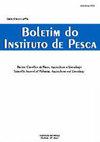Reconstruction of shrimp catches in Brazil based on generalized linear models
IF 0.6
4区 农林科学
Q4 FISHERIES
引用次数: 0
Abstract
Catch data comprises important information for assessing the status of several fisheries. However, it is not always available. A modeling approach using generalized linear models was performed to rebuild catch data supported by environmental variables. Catch information was provided by fisheries’ statistical bulletins about pink (Farfantepenaeus subtilis, F. brasiliensis, and F. paulensis), white (Litopenaeus schmitti), and seabob shrimp (Xiphopenaeus kroyeri). Sea surface temperature and rainfall information were collected from open-access databases by meteorological agencies. Due to low species discrimination over time, a general shrimp catch category was added to the models to help disaggregate quantities for each species. The general category was the most relevant variable, whereas temperature indices showed reduction patterns in catches over time, which may indicate the likely effects of temperature increase on shrimp fisheries. Beyond that, extreme peaks and falls testedthrough residual analysis indicate low reliability mainly in the 1970s and ’80s reports. Information gain varied according to the discrimination ability. States that took longer to discriminate the species presented predictions far from the reports, so the information gains were greater than 100%. Accordingly, reconstructions can be an alternative to restore outdated or missing information and help judge the reliability of official data.基于广义线性模型的巴西对虾捕捞量重建
渔获量数据是评估若干渔场状况的重要资料。然而,它并不总是可用的。采用广义线性模型重建环境变量支持下的捕捞数据。渔业统计公报提供了关于粉虾(Farfantepenaeus subtilis, F. brasiliensis和F. paulensis)、白虾(Litopenaeus schmitti)和海对虾(Xiphopenaeus kroyeri)的捕捞信息。海面温度和降雨信息由气象机构从开放获取的数据库中收集。由于随着时间的推移,物种歧视程度较低,因此在模型中添加了一般虾捕捞类别,以帮助分解每个物种的数量。一般类别是最相关的变量,而温度指数显示了随着时间的推移渔获量的减少模式,这可能表明温度升高对虾类渔业的可能影响。除此之外,通过残差分析测试的极端峰值和下降表明,低可靠性主要出现在20世纪70年代和80年代的报告中。信息增益随识别能力的不同而不同。那些花更长的时间来区分物种的州给出的预测与报告相差甚远,因此信息收益大于100%。因此,重建可以作为一种替代方法来恢复过时或缺失的信息,并有助于判断官方数据的可靠性。
本文章由计算机程序翻译,如有差异,请以英文原文为准。
求助全文
约1分钟内获得全文
求助全文
来源期刊

Boletim do Instituto de Pesca
FISHERIES-ZOOLOGY
CiteScore
0.80
自引率
0.00%
发文量
24
审稿时长
>12 weeks
期刊介绍:
To publish original articles of research and short communications in the following áreas: Fisheries, Aquaculture, Zootechnology, Limnology, Oceanography, Biology and Pathology of aquatic organisms. The publication depends on the approval of the Editorial Board, based on the peer review.
 求助内容:
求助内容: 应助结果提醒方式:
应助结果提醒方式:


